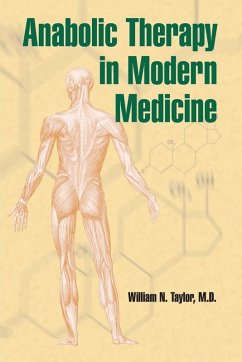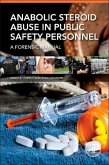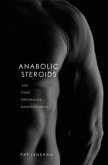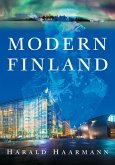William N. Taylor
Anabolic Therapy in Modern Medicine
William N. Taylor
Anabolic Therapy in Modern Medicine
- Broschiertes Buch
- Merkliste
- Auf die Merkliste
- Bewerten Bewerten
- Teilen
- Produkt teilen
- Produkterinnerung
- Produkterinnerung
This technical study compiles information on anabolic therapy, and examines its uses, especially for physical medicine and rehabilitation. The book begins with a description of anabolic agents and their historical medicinal use, and then goes on to consider their use for a wide range of diseases.
Andere Kunden interessierten sich auch für
![Anabolic Steroid Abuse in Public Safety Personnel Anabolic Steroid Abuse in Public Safety Personnel]() Brent E. TurveyAnabolic Steroid Abuse in Public Safety Personnel24,99 €
Brent E. TurveyAnabolic Steroid Abuse in Public Safety Personnel24,99 €![An Introduction to Drugs in Sport An Introduction to Drugs in Sport]() Ivan WaddingtonAn Introduction to Drugs in Sport54,99 €
Ivan WaddingtonAn Introduction to Drugs in Sport54,99 €![Muscle Boys Muscle Boys]() Erick AlvarezMuscle Boys154,99 €
Erick AlvarezMuscle Boys154,99 €![Muscle Boys Muscle Boys]() Erick AlvarezMuscle Boys43,99 €
Erick AlvarezMuscle Boys43,99 €![Clinical Nutrition and Aging Clinical Nutrition and Aging]() Clinical Nutrition and Aging89,99 €
Clinical Nutrition and Aging89,99 €![Anabolic Steroids Anabolic Steroids]() Patrick Lenehan (The Drugs and Merseysid Sport Information ServiceAnabolic Steroids98,99 €
Patrick Lenehan (The Drugs and Merseysid Sport Information ServiceAnabolic Steroids98,99 €![Modern Finland Modern Finland]() Harald HaarmannModern Finland43,99 €
Harald HaarmannModern Finland43,99 €-
-
-
This technical study compiles information on anabolic therapy, and examines its uses, especially for physical medicine and rehabilitation. The book begins with a description of anabolic agents and their historical medicinal use, and then goes on to consider their use for a wide range of diseases.
Produktdetails
- Produktdetails
- Verlag: McFarland & Co Inc
- Seitenzahl: 350
- Erscheinungstermin: 15. Februar 2002
- Englisch
- Abmessung: 229mm x 152mm x 21mm
- Gewicht: 492g
- ISBN-13: 9780786412419
- ISBN-10: 0786412410
- Artikelnr.: 22397217
- Herstellerkennzeichnung
- Libri GmbH
- Europaallee 1
- 36244 Bad Hersfeld
- gpsr@libri.de
- Verlag: McFarland & Co Inc
- Seitenzahl: 350
- Erscheinungstermin: 15. Februar 2002
- Englisch
- Abmessung: 229mm x 152mm x 21mm
- Gewicht: 492g
- ISBN-13: 9780786412419
- ISBN-10: 0786412410
- Artikelnr.: 22397217
- Herstellerkennzeichnung
- Libri GmbH
- Europaallee 1
- 36244 Bad Hersfeld
- gpsr@libri.de
The late William N. Taylor, M.D., wrote widely on aspects of sports, health and medicine. He lived in Pensacola, Florida.
Table of Contents Preface 1 PART I: Androgens: Synthesis and Scope of
Chemical Potentials 1: Introduction: Anabolic Therapy and the Body's
Catabolic Responses to Ill-Health Conditions 5 2: Historical Use of
Anabolic Agents in Medicine 9 Introduction: Defining the Breadth of
Anabolic Agents 9 Defining the Scope of Patients Who Require Anabolic
Therapies 10 Summary: Anabolic Therapy Is the Future of Medicine 11 PART 2:
Anabolic Therapy for Sarcopenia, Osteoporosis, and Hormone Replacement
Therapy 3: Rationale for Anabolic Therapy in Sarcopenia and Frailty
Conditions 15 Introduction: Sarcopenia: The Condition of the 21st Century
15 The Need to Reeducate Health Care Providers 16 Hypoandrogenemia and
Hyposomatomedinemia in Sarcopenia 17 Androgen and Other Anabolic Therapies
for Sarcopenia 18 Androgen Therapy for Sarcopenic States Associated with
Chronic Illnesses 22 Additional Health Benefits of Androgen Therapy in
Sarcopenic States 22 Summary 23 4: Rationale for Anabolic Therapy in
Corticosteroid-Induced Osteoporosis 32 Introduction: Iatrogenic Bone
Disease 32 Hypoandrogenemia and Hyposomatomedinemia in CST-Induced
Osteoporosis 33 REDUCED BONE FORMATION 34 INCREASED BONE RESORPTION 38
ALTERED CALCIUM METABOLISM 38 ALTERED BONE ARCHITECTURE 39 Studies with
Anabolic Therapy for CST-Induced Osteoporosis 39 Summary 42 5: Rationale
for Anabolic Therapy for Postmenopausal Osteoporosis and Hormone
Replacement Therapy in Women 51 Introduction: Postmenopausal Androgen
Deficiency and Underutilization of Androgen Therapy 51 Androgen Deficiency
Links Many Diseases in Postmenopausal Women 53 Barriers for Adequate
Management of Postmenopausal Osteoporosis 55 Androgen Therapy Mimics
Ovarian Function 56 Androgen Therapy Reverses BMD Deficits in
Postmenopausal Osteoporosis 57 Historical Highlights Regarding the Clinical
Use of Androgen Therapy in Women 58 Androgens Directly and Indirectly
Stimulate Normal Bone Formation 62 Androgen Therapy Corrects
Hypoandrogenemia and Hyposomatomedinemia 63 Androgen Therapy Improves
Menopausal Vasomotor Symptoms, Elevates Mood, Increases Libido, Improves
Quality of Life, and Modulates Anabolic Cytokines 64 Impact of
Estrogen-Androgen HRT on Lipids and Thromboemobolic Event Risks 67 Summary
68 6: Rationale for Anabolic Therapy for Osteoporosis and Andropause in Men
88 Introduction: Andropause Contributes to Osteoporosis and Other Diseases
in Men 88 Redefining Andropause in Men 90 Historical Highlights of Androgen
Therapy for Andropause in Men 90 Androgens Directly and Indirectly
Stimulate Normal Bone Formation 92 Androgen Therapy Corrects
Hypoandrogenemia and Hyposomatomedinemia 93 Hypoandrogenemia, Androgen
Therapy, and Risk for Prostate Cancer and Benign Prostatic Hypertrophy 94
Hypoandrogenemia, Androgen Therapy, and Cardiovascular Risk Factors 97
Androgen Therapy and Its Neurosteroid, Neuroprotective, and Neuroimmune
Benefits 99 Summary 100 PART 3: Anabolic Therapy for Autoimmune Diseases 7:
Rationale for Anabolic Therapy in Autoimmune Diseases 119 Introduction:
Abnormal Sex Steroid Profiles? 119 Gender Dimorphism in Autoimmune Diseases
120 Androgens Are Immunomodulating Agents 122 Androgens Are Neuroprotective
and Neuroregenerative Agents 125 Androgens Are Potent Neurosteroids 127
Androgens Are Anabolic Agents 129 Androgens Are Osteoblast Stimulators 130
Summary 130 8: Rationale for Anabolic Therapy in Amyotrophic Lateral
Sclerosis 145 Introduction: Anabolic and Neurotrophin Factor Deficiency?
145 Anabolic Therapy for ALS 147 Summary and Remarks 147 9: Rationale for
Anabolic Therapy in Chronic Fatigue Syndrome 150 Introduction: Chronic
Fatigue Syndrome: A Neurosteroid Deficiency? 150 Hypoandrogenemia and CFS
150 Studies with Anabolic Therapy in CFS 151 Summary 151 10: Rationale for
Anabolic Therapy in Multiple Sclerosis 155 Introduction: A Major Loss of
Anabolic Potentials to Counteract Severe Catabolism 155 Hypoandrogenemia
and Hyposomatomedinemia in MS 156 Anabolic Therapy for MS Patients in
Rehabilitation 157 Summary 158 11: Rationale for Anabolic Therapy in
Rheumatoid Arthritis 164 Introduction: Androgens, the Missing Hormones in
RA 164 Mechanisms of Hypoandrogenemia in RA 165 Androgen Therapy in RA and
for RA-Related Sequelae 167 Summary 168 12: Rationale for Anabolic Therapy
in Sjogren's Syndrome 175 Introduction: Hypoandrogenemia Associated with
Sjogren's Syndrome 175 Pathologic Mechanisms and Hypoandrogenemia in SS 176
Studies with Androgen Therapy in SS 177 Summary 177 13: Rationale for
Anabolic Therapy in Systemic Lupus Erythematosus 183 Introduction: Sex
Hormones and SLE 183 Androgen Deficiency and SLE 184 Studies with Androgen
Therapy in SLE 185 Androgen Therapy and Cytokine Profiles in SLE 186
Summary 187 14: Rationale for Anabolic Therapy in Systemic Sclerosis 193
Introduction: Scleroderma and Androgen Deficiency 193 Studies with Androgen
Therapy for SSc 194 Summary 194 PART 4: Anabolic Therapy for Other
Catabolic Diseases and Conditions 15: Rationale for Anabolic Therapy in
AIDS and HIV Infection 201 Introduction: Hypoandrogenemia and AIDS Wasting
201 Studies of Anabolic Therapy for HIV-Infected Patients 202 Summary 203
16: Rationale for Anabolic Therapy in Burns and Major Thermal Injuries 208
Introduction: A Prolonged Major Catabolic Condition 208 Hypoandrogenemia
and Hyposomatomedinemia in Major Burns 208 Complications and Sequelae of
Thermal Injury-Induced Hypoandrogenemia and Hyposomatomedinemia 209 Studies
of Anabolic Therapy for Major Thermal Injuries 209 Summary 210 17:
Rationale for Anabolic Therapy in Cancer Patients 217 Introduction: The
Anorexia/Cachexia Syndrome: Description and Pharmacologic Management 217
Hypoandrogenemia and Hyposomatomedinemia in Cancer Patients 218 Studies
with Androgen Therapy for Cancer Patients 219 Summary 219 18: Rationale for
Anabolic Therapy in Cardiovascular Diseases and Cardiac Rehabilitation 224
Introduction: Hypoandrogenemia Is a Multifacted Risk Factor for Heart
Disease 224 Hypoandrogenemia Promotes Cardiovascular Disease 225 Incidence
of Hypoandrogenemia and CHD in Men 226 Hypoandrogenemia Contributes to
Hyposomatomedinemia and Heart Disease 227 Androgens Are Beneficial
Cardiovascular Agents 228 Summary 229 19: Rationale for Anabolic Therapy in
Chronic Obstructive Pulmonary Disease 235 Introduction: A Major Catabolic
Condition 235 Hypoandrogenemia in COPD Patients 235 Studies with Anabolic
Therapy in COPD 236 Summary 237 20: Rationale for Anabolic Therapy in
Stroke Treatment and Rehabilitation 241 Introduction: A Lack of Clinical
Use of Anabolic Agents for Stroke Patients 241 Androgen Deficiency and Low
Anabolic Stimuli in Stroke Patients 243 Androgen Deficiency, Atherogenesis,
Fibrinolysis, and Thromboembolic Events 244 Androgens Are Neuroprotective
Neurosteroids and Neuroendocrine Modulators of the Cytokine System 245
Conclusion: Androgens Play a Key Role in the Entire Constellation of Stroke
Pathogenesis, Recovery, and Rehabilitation 246 Recommendations for Anabolic
Therapy 250 21: Rationale for Anabolic Therapy in Type II Diabetes in Men:
Medical Management and Rehabilitation 261 Introduction: Gender Dimorphism
in Type II Diabetes 261 Hypoandrogenemia in Men with Type II Diabetes 263
Hypoandrogenemia Induces Hyposomatomedinemia in Men with Type II Diabetes
265 Consequences of Hypoandrogenemia and Hyposomatomedinemia in Men with
Type II Diabetes 266 Available Studies of Androgen Therapy for Type II
Diabetes in Men 267 Recommendations for Anabolic Therapy in Men with Type
II Diabetes 267 22: Rationale for Anabolic Therapy in Chronic Renal Failure
274 Introduction: Uremic Hypoandrogenemia and Its Dramatic Clinical and
Financial Impacts 274 Hypoandrogenemia in Patients with CRF 275
Hypoandrogenemia-Related Diseases and Conditions in Patients with CRF 276
Studies with Anabolic Therapy in CRF 277 Summary 278 23: Rationale for
Anabolic Therapy in Muscular Dystrophy and Other Primary Myopathies 283
Introduction: Many Myopathies Are Associated with Hypoandrogenemia 283
Anabolic Therapy for Myopathies 284 Summary 285 24: Rationale for Anabolic
Therapy in Spinal Cord Injury 289 Introduction: Spinal Cord Injury Creates
Catabolic Endocrine Abnormalities 289 Studies with Anabolic Therapy in SCI
290 Summary 291 25: Rationale for Anabolic Therapy in Alzheimer's Disease
and Cognition Deficits 294 Introduction: Reduced Anabolic Potentials A¿ect
Cognition 294 Studies with Anabolic Agents in Cognitive Dysfunction and AD
295 Summary 296 26: Rationale for Anabolic Therapy in Osteoarthritis 300
Introduction: Reduced Anabolic Processes Result in Joint Destruction 300
Systemic and Local Anabolic Losses in Osteoarthritis 300 Studies with
Anabolic Therapy in Osteoarthritis 301 Summary 302 27: Rationale for
Anabolic Therapy in Prolonged Immobilization, Microgravity, and Extended
Space Travel 305 Introduction: Dramatic Losses of Anabolic Potentials 305
Studies with Anabolic Therapy for Immobilization and Microgravity
Conditions 306 Summary 307 28: Rationale for Anabolic Therapy with
Nutritional Replacement Treatments 309 Introduction: Critical Illness Is
Associated with Profound Catabolism and Reduced Recuperative Abilities 309
Studies with Anabolic Agents and Nutritional Support 310 Anabolic Therapy
with GHRH-GH-IGF-IGFBP Axis Components 311 Summary 312 29: Rationale for
Anabolic Therapy in Dermatological Maladies and Wound Healing 316
Introduction: Loss of Anabolic Potentials Delays Wound Healing 316 Anabolic
Therapy and Mechanisms of Action for Wound Healing 317 Summary 317 30:
Rationale for Anabolic Therapy in Miscellaneous Ill-Health Conditions 320
Introduction: Loss of Anabolic Potential Can Result in a Variety of
Ill-Health Conditions 320 Fibromyalgia 320 Skeletal Muscle Contusions and
Injuries 321 Major Joint Replacement: Preoperational and Rehabilitation 321
Traumatic Brain Injury 322 Summary 322 Afterword: Hypoandrogenemia Is the
Most Commonly Missed Disorder in Modern Medicine 327 Index 329 About the
Author 337
Chemical Potentials 1: Introduction: Anabolic Therapy and the Body's
Catabolic Responses to Ill-Health Conditions 5 2: Historical Use of
Anabolic Agents in Medicine 9 Introduction: Defining the Breadth of
Anabolic Agents 9 Defining the Scope of Patients Who Require Anabolic
Therapies 10 Summary: Anabolic Therapy Is the Future of Medicine 11 PART 2:
Anabolic Therapy for Sarcopenia, Osteoporosis, and Hormone Replacement
Therapy 3: Rationale for Anabolic Therapy in Sarcopenia and Frailty
Conditions 15 Introduction: Sarcopenia: The Condition of the 21st Century
15 The Need to Reeducate Health Care Providers 16 Hypoandrogenemia and
Hyposomatomedinemia in Sarcopenia 17 Androgen and Other Anabolic Therapies
for Sarcopenia 18 Androgen Therapy for Sarcopenic States Associated with
Chronic Illnesses 22 Additional Health Benefits of Androgen Therapy in
Sarcopenic States 22 Summary 23 4: Rationale for Anabolic Therapy in
Corticosteroid-Induced Osteoporosis 32 Introduction: Iatrogenic Bone
Disease 32 Hypoandrogenemia and Hyposomatomedinemia in CST-Induced
Osteoporosis 33 REDUCED BONE FORMATION 34 INCREASED BONE RESORPTION 38
ALTERED CALCIUM METABOLISM 38 ALTERED BONE ARCHITECTURE 39 Studies with
Anabolic Therapy for CST-Induced Osteoporosis 39 Summary 42 5: Rationale
for Anabolic Therapy for Postmenopausal Osteoporosis and Hormone
Replacement Therapy in Women 51 Introduction: Postmenopausal Androgen
Deficiency and Underutilization of Androgen Therapy 51 Androgen Deficiency
Links Many Diseases in Postmenopausal Women 53 Barriers for Adequate
Management of Postmenopausal Osteoporosis 55 Androgen Therapy Mimics
Ovarian Function 56 Androgen Therapy Reverses BMD Deficits in
Postmenopausal Osteoporosis 57 Historical Highlights Regarding the Clinical
Use of Androgen Therapy in Women 58 Androgens Directly and Indirectly
Stimulate Normal Bone Formation 62 Androgen Therapy Corrects
Hypoandrogenemia and Hyposomatomedinemia 63 Androgen Therapy Improves
Menopausal Vasomotor Symptoms, Elevates Mood, Increases Libido, Improves
Quality of Life, and Modulates Anabolic Cytokines 64 Impact of
Estrogen-Androgen HRT on Lipids and Thromboemobolic Event Risks 67 Summary
68 6: Rationale for Anabolic Therapy for Osteoporosis and Andropause in Men
88 Introduction: Andropause Contributes to Osteoporosis and Other Diseases
in Men 88 Redefining Andropause in Men 90 Historical Highlights of Androgen
Therapy for Andropause in Men 90 Androgens Directly and Indirectly
Stimulate Normal Bone Formation 92 Androgen Therapy Corrects
Hypoandrogenemia and Hyposomatomedinemia 93 Hypoandrogenemia, Androgen
Therapy, and Risk for Prostate Cancer and Benign Prostatic Hypertrophy 94
Hypoandrogenemia, Androgen Therapy, and Cardiovascular Risk Factors 97
Androgen Therapy and Its Neurosteroid, Neuroprotective, and Neuroimmune
Benefits 99 Summary 100 PART 3: Anabolic Therapy for Autoimmune Diseases 7:
Rationale for Anabolic Therapy in Autoimmune Diseases 119 Introduction:
Abnormal Sex Steroid Profiles? 119 Gender Dimorphism in Autoimmune Diseases
120 Androgens Are Immunomodulating Agents 122 Androgens Are Neuroprotective
and Neuroregenerative Agents 125 Androgens Are Potent Neurosteroids 127
Androgens Are Anabolic Agents 129 Androgens Are Osteoblast Stimulators 130
Summary 130 8: Rationale for Anabolic Therapy in Amyotrophic Lateral
Sclerosis 145 Introduction: Anabolic and Neurotrophin Factor Deficiency?
145 Anabolic Therapy for ALS 147 Summary and Remarks 147 9: Rationale for
Anabolic Therapy in Chronic Fatigue Syndrome 150 Introduction: Chronic
Fatigue Syndrome: A Neurosteroid Deficiency? 150 Hypoandrogenemia and CFS
150 Studies with Anabolic Therapy in CFS 151 Summary 151 10: Rationale for
Anabolic Therapy in Multiple Sclerosis 155 Introduction: A Major Loss of
Anabolic Potentials to Counteract Severe Catabolism 155 Hypoandrogenemia
and Hyposomatomedinemia in MS 156 Anabolic Therapy for MS Patients in
Rehabilitation 157 Summary 158 11: Rationale for Anabolic Therapy in
Rheumatoid Arthritis 164 Introduction: Androgens, the Missing Hormones in
RA 164 Mechanisms of Hypoandrogenemia in RA 165 Androgen Therapy in RA and
for RA-Related Sequelae 167 Summary 168 12: Rationale for Anabolic Therapy
in Sjogren's Syndrome 175 Introduction: Hypoandrogenemia Associated with
Sjogren's Syndrome 175 Pathologic Mechanisms and Hypoandrogenemia in SS 176
Studies with Androgen Therapy in SS 177 Summary 177 13: Rationale for
Anabolic Therapy in Systemic Lupus Erythematosus 183 Introduction: Sex
Hormones and SLE 183 Androgen Deficiency and SLE 184 Studies with Androgen
Therapy in SLE 185 Androgen Therapy and Cytokine Profiles in SLE 186
Summary 187 14: Rationale for Anabolic Therapy in Systemic Sclerosis 193
Introduction: Scleroderma and Androgen Deficiency 193 Studies with Androgen
Therapy for SSc 194 Summary 194 PART 4: Anabolic Therapy for Other
Catabolic Diseases and Conditions 15: Rationale for Anabolic Therapy in
AIDS and HIV Infection 201 Introduction: Hypoandrogenemia and AIDS Wasting
201 Studies of Anabolic Therapy for HIV-Infected Patients 202 Summary 203
16: Rationale for Anabolic Therapy in Burns and Major Thermal Injuries 208
Introduction: A Prolonged Major Catabolic Condition 208 Hypoandrogenemia
and Hyposomatomedinemia in Major Burns 208 Complications and Sequelae of
Thermal Injury-Induced Hypoandrogenemia and Hyposomatomedinemia 209 Studies
of Anabolic Therapy for Major Thermal Injuries 209 Summary 210 17:
Rationale for Anabolic Therapy in Cancer Patients 217 Introduction: The
Anorexia/Cachexia Syndrome: Description and Pharmacologic Management 217
Hypoandrogenemia and Hyposomatomedinemia in Cancer Patients 218 Studies
with Androgen Therapy for Cancer Patients 219 Summary 219 18: Rationale for
Anabolic Therapy in Cardiovascular Diseases and Cardiac Rehabilitation 224
Introduction: Hypoandrogenemia Is a Multifacted Risk Factor for Heart
Disease 224 Hypoandrogenemia Promotes Cardiovascular Disease 225 Incidence
of Hypoandrogenemia and CHD in Men 226 Hypoandrogenemia Contributes to
Hyposomatomedinemia and Heart Disease 227 Androgens Are Beneficial
Cardiovascular Agents 228 Summary 229 19: Rationale for Anabolic Therapy in
Chronic Obstructive Pulmonary Disease 235 Introduction: A Major Catabolic
Condition 235 Hypoandrogenemia in COPD Patients 235 Studies with Anabolic
Therapy in COPD 236 Summary 237 20: Rationale for Anabolic Therapy in
Stroke Treatment and Rehabilitation 241 Introduction: A Lack of Clinical
Use of Anabolic Agents for Stroke Patients 241 Androgen Deficiency and Low
Anabolic Stimuli in Stroke Patients 243 Androgen Deficiency, Atherogenesis,
Fibrinolysis, and Thromboembolic Events 244 Androgens Are Neuroprotective
Neurosteroids and Neuroendocrine Modulators of the Cytokine System 245
Conclusion: Androgens Play a Key Role in the Entire Constellation of Stroke
Pathogenesis, Recovery, and Rehabilitation 246 Recommendations for Anabolic
Therapy 250 21: Rationale for Anabolic Therapy in Type II Diabetes in Men:
Medical Management and Rehabilitation 261 Introduction: Gender Dimorphism
in Type II Diabetes 261 Hypoandrogenemia in Men with Type II Diabetes 263
Hypoandrogenemia Induces Hyposomatomedinemia in Men with Type II Diabetes
265 Consequences of Hypoandrogenemia and Hyposomatomedinemia in Men with
Type II Diabetes 266 Available Studies of Androgen Therapy for Type II
Diabetes in Men 267 Recommendations for Anabolic Therapy in Men with Type
II Diabetes 267 22: Rationale for Anabolic Therapy in Chronic Renal Failure
274 Introduction: Uremic Hypoandrogenemia and Its Dramatic Clinical and
Financial Impacts 274 Hypoandrogenemia in Patients with CRF 275
Hypoandrogenemia-Related Diseases and Conditions in Patients with CRF 276
Studies with Anabolic Therapy in CRF 277 Summary 278 23: Rationale for
Anabolic Therapy in Muscular Dystrophy and Other Primary Myopathies 283
Introduction: Many Myopathies Are Associated with Hypoandrogenemia 283
Anabolic Therapy for Myopathies 284 Summary 285 24: Rationale for Anabolic
Therapy in Spinal Cord Injury 289 Introduction: Spinal Cord Injury Creates
Catabolic Endocrine Abnormalities 289 Studies with Anabolic Therapy in SCI
290 Summary 291 25: Rationale for Anabolic Therapy in Alzheimer's Disease
and Cognition Deficits 294 Introduction: Reduced Anabolic Potentials A¿ect
Cognition 294 Studies with Anabolic Agents in Cognitive Dysfunction and AD
295 Summary 296 26: Rationale for Anabolic Therapy in Osteoarthritis 300
Introduction: Reduced Anabolic Processes Result in Joint Destruction 300
Systemic and Local Anabolic Losses in Osteoarthritis 300 Studies with
Anabolic Therapy in Osteoarthritis 301 Summary 302 27: Rationale for
Anabolic Therapy in Prolonged Immobilization, Microgravity, and Extended
Space Travel 305 Introduction: Dramatic Losses of Anabolic Potentials 305
Studies with Anabolic Therapy for Immobilization and Microgravity
Conditions 306 Summary 307 28: Rationale for Anabolic Therapy with
Nutritional Replacement Treatments 309 Introduction: Critical Illness Is
Associated with Profound Catabolism and Reduced Recuperative Abilities 309
Studies with Anabolic Agents and Nutritional Support 310 Anabolic Therapy
with GHRH-GH-IGF-IGFBP Axis Components 311 Summary 312 29: Rationale for
Anabolic Therapy in Dermatological Maladies and Wound Healing 316
Introduction: Loss of Anabolic Potentials Delays Wound Healing 316 Anabolic
Therapy and Mechanisms of Action for Wound Healing 317 Summary 317 30:
Rationale for Anabolic Therapy in Miscellaneous Ill-Health Conditions 320
Introduction: Loss of Anabolic Potential Can Result in a Variety of
Ill-Health Conditions 320 Fibromyalgia 320 Skeletal Muscle Contusions and
Injuries 321 Major Joint Replacement: Preoperational and Rehabilitation 321
Traumatic Brain Injury 322 Summary 322 Afterword: Hypoandrogenemia Is the
Most Commonly Missed Disorder in Modern Medicine 327 Index 329 About the
Author 337
Table of Contents Preface 1 PART I: Androgens: Synthesis and Scope of
Chemical Potentials 1: Introduction: Anabolic Therapy and the Body's
Catabolic Responses to Ill-Health Conditions 5 2: Historical Use of
Anabolic Agents in Medicine 9 Introduction: Defining the Breadth of
Anabolic Agents 9 Defining the Scope of Patients Who Require Anabolic
Therapies 10 Summary: Anabolic Therapy Is the Future of Medicine 11 PART 2:
Anabolic Therapy for Sarcopenia, Osteoporosis, and Hormone Replacement
Therapy 3: Rationale for Anabolic Therapy in Sarcopenia and Frailty
Conditions 15 Introduction: Sarcopenia: The Condition of the 21st Century
15 The Need to Reeducate Health Care Providers 16 Hypoandrogenemia and
Hyposomatomedinemia in Sarcopenia 17 Androgen and Other Anabolic Therapies
for Sarcopenia 18 Androgen Therapy for Sarcopenic States Associated with
Chronic Illnesses 22 Additional Health Benefits of Androgen Therapy in
Sarcopenic States 22 Summary 23 4: Rationale for Anabolic Therapy in
Corticosteroid-Induced Osteoporosis 32 Introduction: Iatrogenic Bone
Disease 32 Hypoandrogenemia and Hyposomatomedinemia in CST-Induced
Osteoporosis 33 REDUCED BONE FORMATION 34 INCREASED BONE RESORPTION 38
ALTERED CALCIUM METABOLISM 38 ALTERED BONE ARCHITECTURE 39 Studies with
Anabolic Therapy for CST-Induced Osteoporosis 39 Summary 42 5: Rationale
for Anabolic Therapy for Postmenopausal Osteoporosis and Hormone
Replacement Therapy in Women 51 Introduction: Postmenopausal Androgen
Deficiency and Underutilization of Androgen Therapy 51 Androgen Deficiency
Links Many Diseases in Postmenopausal Women 53 Barriers for Adequate
Management of Postmenopausal Osteoporosis 55 Androgen Therapy Mimics
Ovarian Function 56 Androgen Therapy Reverses BMD Deficits in
Postmenopausal Osteoporosis 57 Historical Highlights Regarding the Clinical
Use of Androgen Therapy in Women 58 Androgens Directly and Indirectly
Stimulate Normal Bone Formation 62 Androgen Therapy Corrects
Hypoandrogenemia and Hyposomatomedinemia 63 Androgen Therapy Improves
Menopausal Vasomotor Symptoms, Elevates Mood, Increases Libido, Improves
Quality of Life, and Modulates Anabolic Cytokines 64 Impact of
Estrogen-Androgen HRT on Lipids and Thromboemobolic Event Risks 67 Summary
68 6: Rationale for Anabolic Therapy for Osteoporosis and Andropause in Men
88 Introduction: Andropause Contributes to Osteoporosis and Other Diseases
in Men 88 Redefining Andropause in Men 90 Historical Highlights of Androgen
Therapy for Andropause in Men 90 Androgens Directly and Indirectly
Stimulate Normal Bone Formation 92 Androgen Therapy Corrects
Hypoandrogenemia and Hyposomatomedinemia 93 Hypoandrogenemia, Androgen
Therapy, and Risk for Prostate Cancer and Benign Prostatic Hypertrophy 94
Hypoandrogenemia, Androgen Therapy, and Cardiovascular Risk Factors 97
Androgen Therapy and Its Neurosteroid, Neuroprotective, and Neuroimmune
Benefits 99 Summary 100 PART 3: Anabolic Therapy for Autoimmune Diseases 7:
Rationale for Anabolic Therapy in Autoimmune Diseases 119 Introduction:
Abnormal Sex Steroid Profiles? 119 Gender Dimorphism in Autoimmune Diseases
120 Androgens Are Immunomodulating Agents 122 Androgens Are Neuroprotective
and Neuroregenerative Agents 125 Androgens Are Potent Neurosteroids 127
Androgens Are Anabolic Agents 129 Androgens Are Osteoblast Stimulators 130
Summary 130 8: Rationale for Anabolic Therapy in Amyotrophic Lateral
Sclerosis 145 Introduction: Anabolic and Neurotrophin Factor Deficiency?
145 Anabolic Therapy for ALS 147 Summary and Remarks 147 9: Rationale for
Anabolic Therapy in Chronic Fatigue Syndrome 150 Introduction: Chronic
Fatigue Syndrome: A Neurosteroid Deficiency? 150 Hypoandrogenemia and CFS
150 Studies with Anabolic Therapy in CFS 151 Summary 151 10: Rationale for
Anabolic Therapy in Multiple Sclerosis 155 Introduction: A Major Loss of
Anabolic Potentials to Counteract Severe Catabolism 155 Hypoandrogenemia
and Hyposomatomedinemia in MS 156 Anabolic Therapy for MS Patients in
Rehabilitation 157 Summary 158 11: Rationale for Anabolic Therapy in
Rheumatoid Arthritis 164 Introduction: Androgens, the Missing Hormones in
RA 164 Mechanisms of Hypoandrogenemia in RA 165 Androgen Therapy in RA and
for RA-Related Sequelae 167 Summary 168 12: Rationale for Anabolic Therapy
in Sjogren's Syndrome 175 Introduction: Hypoandrogenemia Associated with
Sjogren's Syndrome 175 Pathologic Mechanisms and Hypoandrogenemia in SS 176
Studies with Androgen Therapy in SS 177 Summary 177 13: Rationale for
Anabolic Therapy in Systemic Lupus Erythematosus 183 Introduction: Sex
Hormones and SLE 183 Androgen Deficiency and SLE 184 Studies with Androgen
Therapy in SLE 185 Androgen Therapy and Cytokine Profiles in SLE 186
Summary 187 14: Rationale for Anabolic Therapy in Systemic Sclerosis 193
Introduction: Scleroderma and Androgen Deficiency 193 Studies with Androgen
Therapy for SSc 194 Summary 194 PART 4: Anabolic Therapy for Other
Catabolic Diseases and Conditions 15: Rationale for Anabolic Therapy in
AIDS and HIV Infection 201 Introduction: Hypoandrogenemia and AIDS Wasting
201 Studies of Anabolic Therapy for HIV-Infected Patients 202 Summary 203
16: Rationale for Anabolic Therapy in Burns and Major Thermal Injuries 208
Introduction: A Prolonged Major Catabolic Condition 208 Hypoandrogenemia
and Hyposomatomedinemia in Major Burns 208 Complications and Sequelae of
Thermal Injury-Induced Hypoandrogenemia and Hyposomatomedinemia 209 Studies
of Anabolic Therapy for Major Thermal Injuries 209 Summary 210 17:
Rationale for Anabolic Therapy in Cancer Patients 217 Introduction: The
Anorexia/Cachexia Syndrome: Description and Pharmacologic Management 217
Hypoandrogenemia and Hyposomatomedinemia in Cancer Patients 218 Studies
with Androgen Therapy for Cancer Patients 219 Summary 219 18: Rationale for
Anabolic Therapy in Cardiovascular Diseases and Cardiac Rehabilitation 224
Introduction: Hypoandrogenemia Is a Multifacted Risk Factor for Heart
Disease 224 Hypoandrogenemia Promotes Cardiovascular Disease 225 Incidence
of Hypoandrogenemia and CHD in Men 226 Hypoandrogenemia Contributes to
Hyposomatomedinemia and Heart Disease 227 Androgens Are Beneficial
Cardiovascular Agents 228 Summary 229 19: Rationale for Anabolic Therapy in
Chronic Obstructive Pulmonary Disease 235 Introduction: A Major Catabolic
Condition 235 Hypoandrogenemia in COPD Patients 235 Studies with Anabolic
Therapy in COPD 236 Summary 237 20: Rationale for Anabolic Therapy in
Stroke Treatment and Rehabilitation 241 Introduction: A Lack of Clinical
Use of Anabolic Agents for Stroke Patients 241 Androgen Deficiency and Low
Anabolic Stimuli in Stroke Patients 243 Androgen Deficiency, Atherogenesis,
Fibrinolysis, and Thromboembolic Events 244 Androgens Are Neuroprotective
Neurosteroids and Neuroendocrine Modulators of the Cytokine System 245
Conclusion: Androgens Play a Key Role in the Entire Constellation of Stroke
Pathogenesis, Recovery, and Rehabilitation 246 Recommendations for Anabolic
Therapy 250 21: Rationale for Anabolic Therapy in Type II Diabetes in Men:
Medical Management and Rehabilitation 261 Introduction: Gender Dimorphism
in Type II Diabetes 261 Hypoandrogenemia in Men with Type II Diabetes 263
Hypoandrogenemia Induces Hyposomatomedinemia in Men with Type II Diabetes
265 Consequences of Hypoandrogenemia and Hyposomatomedinemia in Men with
Type II Diabetes 266 Available Studies of Androgen Therapy for Type II
Diabetes in Men 267 Recommendations for Anabolic Therapy in Men with Type
II Diabetes 267 22: Rationale for Anabolic Therapy in Chronic Renal Failure
274 Introduction: Uremic Hypoandrogenemia and Its Dramatic Clinical and
Financial Impacts 274 Hypoandrogenemia in Patients with CRF 275
Hypoandrogenemia-Related Diseases and Conditions in Patients with CRF 276
Studies with Anabolic Therapy in CRF 277 Summary 278 23: Rationale for
Anabolic Therapy in Muscular Dystrophy and Other Primary Myopathies 283
Introduction: Many Myopathies Are Associated with Hypoandrogenemia 283
Anabolic Therapy for Myopathies 284 Summary 285 24: Rationale for Anabolic
Therapy in Spinal Cord Injury 289 Introduction: Spinal Cord Injury Creates
Catabolic Endocrine Abnormalities 289 Studies with Anabolic Therapy in SCI
290 Summary 291 25: Rationale for Anabolic Therapy in Alzheimer's Disease
and Cognition Deficits 294 Introduction: Reduced Anabolic Potentials A¿ect
Cognition 294 Studies with Anabolic Agents in Cognitive Dysfunction and AD
295 Summary 296 26: Rationale for Anabolic Therapy in Osteoarthritis 300
Introduction: Reduced Anabolic Processes Result in Joint Destruction 300
Systemic and Local Anabolic Losses in Osteoarthritis 300 Studies with
Anabolic Therapy in Osteoarthritis 301 Summary 302 27: Rationale for
Anabolic Therapy in Prolonged Immobilization, Microgravity, and Extended
Space Travel 305 Introduction: Dramatic Losses of Anabolic Potentials 305
Studies with Anabolic Therapy for Immobilization and Microgravity
Conditions 306 Summary 307 28: Rationale for Anabolic Therapy with
Nutritional Replacement Treatments 309 Introduction: Critical Illness Is
Associated with Profound Catabolism and Reduced Recuperative Abilities 309
Studies with Anabolic Agents and Nutritional Support 310 Anabolic Therapy
with GHRH-GH-IGF-IGFBP Axis Components 311 Summary 312 29: Rationale for
Anabolic Therapy in Dermatological Maladies and Wound Healing 316
Introduction: Loss of Anabolic Potentials Delays Wound Healing 316 Anabolic
Therapy and Mechanisms of Action for Wound Healing 317 Summary 317 30:
Rationale for Anabolic Therapy in Miscellaneous Ill-Health Conditions 320
Introduction: Loss of Anabolic Potential Can Result in a Variety of
Ill-Health Conditions 320 Fibromyalgia 320 Skeletal Muscle Contusions and
Injuries 321 Major Joint Replacement: Preoperational and Rehabilitation 321
Traumatic Brain Injury 322 Summary 322 Afterword: Hypoandrogenemia Is the
Most Commonly Missed Disorder in Modern Medicine 327 Index 329 About the
Author 337
Chemical Potentials 1: Introduction: Anabolic Therapy and the Body's
Catabolic Responses to Ill-Health Conditions 5 2: Historical Use of
Anabolic Agents in Medicine 9 Introduction: Defining the Breadth of
Anabolic Agents 9 Defining the Scope of Patients Who Require Anabolic
Therapies 10 Summary: Anabolic Therapy Is the Future of Medicine 11 PART 2:
Anabolic Therapy for Sarcopenia, Osteoporosis, and Hormone Replacement
Therapy 3: Rationale for Anabolic Therapy in Sarcopenia and Frailty
Conditions 15 Introduction: Sarcopenia: The Condition of the 21st Century
15 The Need to Reeducate Health Care Providers 16 Hypoandrogenemia and
Hyposomatomedinemia in Sarcopenia 17 Androgen and Other Anabolic Therapies
for Sarcopenia 18 Androgen Therapy for Sarcopenic States Associated with
Chronic Illnesses 22 Additional Health Benefits of Androgen Therapy in
Sarcopenic States 22 Summary 23 4: Rationale for Anabolic Therapy in
Corticosteroid-Induced Osteoporosis 32 Introduction: Iatrogenic Bone
Disease 32 Hypoandrogenemia and Hyposomatomedinemia in CST-Induced
Osteoporosis 33 REDUCED BONE FORMATION 34 INCREASED BONE RESORPTION 38
ALTERED CALCIUM METABOLISM 38 ALTERED BONE ARCHITECTURE 39 Studies with
Anabolic Therapy for CST-Induced Osteoporosis 39 Summary 42 5: Rationale
for Anabolic Therapy for Postmenopausal Osteoporosis and Hormone
Replacement Therapy in Women 51 Introduction: Postmenopausal Androgen
Deficiency and Underutilization of Androgen Therapy 51 Androgen Deficiency
Links Many Diseases in Postmenopausal Women 53 Barriers for Adequate
Management of Postmenopausal Osteoporosis 55 Androgen Therapy Mimics
Ovarian Function 56 Androgen Therapy Reverses BMD Deficits in
Postmenopausal Osteoporosis 57 Historical Highlights Regarding the Clinical
Use of Androgen Therapy in Women 58 Androgens Directly and Indirectly
Stimulate Normal Bone Formation 62 Androgen Therapy Corrects
Hypoandrogenemia and Hyposomatomedinemia 63 Androgen Therapy Improves
Menopausal Vasomotor Symptoms, Elevates Mood, Increases Libido, Improves
Quality of Life, and Modulates Anabolic Cytokines 64 Impact of
Estrogen-Androgen HRT on Lipids and Thromboemobolic Event Risks 67 Summary
68 6: Rationale for Anabolic Therapy for Osteoporosis and Andropause in Men
88 Introduction: Andropause Contributes to Osteoporosis and Other Diseases
in Men 88 Redefining Andropause in Men 90 Historical Highlights of Androgen
Therapy for Andropause in Men 90 Androgens Directly and Indirectly
Stimulate Normal Bone Formation 92 Androgen Therapy Corrects
Hypoandrogenemia and Hyposomatomedinemia 93 Hypoandrogenemia, Androgen
Therapy, and Risk for Prostate Cancer and Benign Prostatic Hypertrophy 94
Hypoandrogenemia, Androgen Therapy, and Cardiovascular Risk Factors 97
Androgen Therapy and Its Neurosteroid, Neuroprotective, and Neuroimmune
Benefits 99 Summary 100 PART 3: Anabolic Therapy for Autoimmune Diseases 7:
Rationale for Anabolic Therapy in Autoimmune Diseases 119 Introduction:
Abnormal Sex Steroid Profiles? 119 Gender Dimorphism in Autoimmune Diseases
120 Androgens Are Immunomodulating Agents 122 Androgens Are Neuroprotective
and Neuroregenerative Agents 125 Androgens Are Potent Neurosteroids 127
Androgens Are Anabolic Agents 129 Androgens Are Osteoblast Stimulators 130
Summary 130 8: Rationale for Anabolic Therapy in Amyotrophic Lateral
Sclerosis 145 Introduction: Anabolic and Neurotrophin Factor Deficiency?
145 Anabolic Therapy for ALS 147 Summary and Remarks 147 9: Rationale for
Anabolic Therapy in Chronic Fatigue Syndrome 150 Introduction: Chronic
Fatigue Syndrome: A Neurosteroid Deficiency? 150 Hypoandrogenemia and CFS
150 Studies with Anabolic Therapy in CFS 151 Summary 151 10: Rationale for
Anabolic Therapy in Multiple Sclerosis 155 Introduction: A Major Loss of
Anabolic Potentials to Counteract Severe Catabolism 155 Hypoandrogenemia
and Hyposomatomedinemia in MS 156 Anabolic Therapy for MS Patients in
Rehabilitation 157 Summary 158 11: Rationale for Anabolic Therapy in
Rheumatoid Arthritis 164 Introduction: Androgens, the Missing Hormones in
RA 164 Mechanisms of Hypoandrogenemia in RA 165 Androgen Therapy in RA and
for RA-Related Sequelae 167 Summary 168 12: Rationale for Anabolic Therapy
in Sjogren's Syndrome 175 Introduction: Hypoandrogenemia Associated with
Sjogren's Syndrome 175 Pathologic Mechanisms and Hypoandrogenemia in SS 176
Studies with Androgen Therapy in SS 177 Summary 177 13: Rationale for
Anabolic Therapy in Systemic Lupus Erythematosus 183 Introduction: Sex
Hormones and SLE 183 Androgen Deficiency and SLE 184 Studies with Androgen
Therapy in SLE 185 Androgen Therapy and Cytokine Profiles in SLE 186
Summary 187 14: Rationale for Anabolic Therapy in Systemic Sclerosis 193
Introduction: Scleroderma and Androgen Deficiency 193 Studies with Androgen
Therapy for SSc 194 Summary 194 PART 4: Anabolic Therapy for Other
Catabolic Diseases and Conditions 15: Rationale for Anabolic Therapy in
AIDS and HIV Infection 201 Introduction: Hypoandrogenemia and AIDS Wasting
201 Studies of Anabolic Therapy for HIV-Infected Patients 202 Summary 203
16: Rationale for Anabolic Therapy in Burns and Major Thermal Injuries 208
Introduction: A Prolonged Major Catabolic Condition 208 Hypoandrogenemia
and Hyposomatomedinemia in Major Burns 208 Complications and Sequelae of
Thermal Injury-Induced Hypoandrogenemia and Hyposomatomedinemia 209 Studies
of Anabolic Therapy for Major Thermal Injuries 209 Summary 210 17:
Rationale for Anabolic Therapy in Cancer Patients 217 Introduction: The
Anorexia/Cachexia Syndrome: Description and Pharmacologic Management 217
Hypoandrogenemia and Hyposomatomedinemia in Cancer Patients 218 Studies
with Androgen Therapy for Cancer Patients 219 Summary 219 18: Rationale for
Anabolic Therapy in Cardiovascular Diseases and Cardiac Rehabilitation 224
Introduction: Hypoandrogenemia Is a Multifacted Risk Factor for Heart
Disease 224 Hypoandrogenemia Promotes Cardiovascular Disease 225 Incidence
of Hypoandrogenemia and CHD in Men 226 Hypoandrogenemia Contributes to
Hyposomatomedinemia and Heart Disease 227 Androgens Are Beneficial
Cardiovascular Agents 228 Summary 229 19: Rationale for Anabolic Therapy in
Chronic Obstructive Pulmonary Disease 235 Introduction: A Major Catabolic
Condition 235 Hypoandrogenemia in COPD Patients 235 Studies with Anabolic
Therapy in COPD 236 Summary 237 20: Rationale for Anabolic Therapy in
Stroke Treatment and Rehabilitation 241 Introduction: A Lack of Clinical
Use of Anabolic Agents for Stroke Patients 241 Androgen Deficiency and Low
Anabolic Stimuli in Stroke Patients 243 Androgen Deficiency, Atherogenesis,
Fibrinolysis, and Thromboembolic Events 244 Androgens Are Neuroprotective
Neurosteroids and Neuroendocrine Modulators of the Cytokine System 245
Conclusion: Androgens Play a Key Role in the Entire Constellation of Stroke
Pathogenesis, Recovery, and Rehabilitation 246 Recommendations for Anabolic
Therapy 250 21: Rationale for Anabolic Therapy in Type II Diabetes in Men:
Medical Management and Rehabilitation 261 Introduction: Gender Dimorphism
in Type II Diabetes 261 Hypoandrogenemia in Men with Type II Diabetes 263
Hypoandrogenemia Induces Hyposomatomedinemia in Men with Type II Diabetes
265 Consequences of Hypoandrogenemia and Hyposomatomedinemia in Men with
Type II Diabetes 266 Available Studies of Androgen Therapy for Type II
Diabetes in Men 267 Recommendations for Anabolic Therapy in Men with Type
II Diabetes 267 22: Rationale for Anabolic Therapy in Chronic Renal Failure
274 Introduction: Uremic Hypoandrogenemia and Its Dramatic Clinical and
Financial Impacts 274 Hypoandrogenemia in Patients with CRF 275
Hypoandrogenemia-Related Diseases and Conditions in Patients with CRF 276
Studies with Anabolic Therapy in CRF 277 Summary 278 23: Rationale for
Anabolic Therapy in Muscular Dystrophy and Other Primary Myopathies 283
Introduction: Many Myopathies Are Associated with Hypoandrogenemia 283
Anabolic Therapy for Myopathies 284 Summary 285 24: Rationale for Anabolic
Therapy in Spinal Cord Injury 289 Introduction: Spinal Cord Injury Creates
Catabolic Endocrine Abnormalities 289 Studies with Anabolic Therapy in SCI
290 Summary 291 25: Rationale for Anabolic Therapy in Alzheimer's Disease
and Cognition Deficits 294 Introduction: Reduced Anabolic Potentials A¿ect
Cognition 294 Studies with Anabolic Agents in Cognitive Dysfunction and AD
295 Summary 296 26: Rationale for Anabolic Therapy in Osteoarthritis 300
Introduction: Reduced Anabolic Processes Result in Joint Destruction 300
Systemic and Local Anabolic Losses in Osteoarthritis 300 Studies with
Anabolic Therapy in Osteoarthritis 301 Summary 302 27: Rationale for
Anabolic Therapy in Prolonged Immobilization, Microgravity, and Extended
Space Travel 305 Introduction: Dramatic Losses of Anabolic Potentials 305
Studies with Anabolic Therapy for Immobilization and Microgravity
Conditions 306 Summary 307 28: Rationale for Anabolic Therapy with
Nutritional Replacement Treatments 309 Introduction: Critical Illness Is
Associated with Profound Catabolism and Reduced Recuperative Abilities 309
Studies with Anabolic Agents and Nutritional Support 310 Anabolic Therapy
with GHRH-GH-IGF-IGFBP Axis Components 311 Summary 312 29: Rationale for
Anabolic Therapy in Dermatological Maladies and Wound Healing 316
Introduction: Loss of Anabolic Potentials Delays Wound Healing 316 Anabolic
Therapy and Mechanisms of Action for Wound Healing 317 Summary 317 30:
Rationale for Anabolic Therapy in Miscellaneous Ill-Health Conditions 320
Introduction: Loss of Anabolic Potential Can Result in a Variety of
Ill-Health Conditions 320 Fibromyalgia 320 Skeletal Muscle Contusions and
Injuries 321 Major Joint Replacement: Preoperational and Rehabilitation 321
Traumatic Brain Injury 322 Summary 322 Afterword: Hypoandrogenemia Is the
Most Commonly Missed Disorder in Modern Medicine 327 Index 329 About the
Author 337








